|
"The old (Maori)
warrior first attacked him (1769
demonstration,
not real human) with his lance, advancing with a most furious
aspect. Having pierced him, the patoo-patoo (hard
stone hand club) was used to demolish
his head, at which he struck with a force which would at one blow have
split any man's skull: from whence we concluded no quarter was given by
these people to their foes in time of action."--------1784-1786,
from account of Captain Cook's first voyage within bound text published
in 80 parts,
George William Anderson, "---Complete Collection Of Voyages Round
The World---Captain Cook's First, Second, Third And Last Voyages,---" p. 45-46.
"Patu is the
name given to a group of thrusting weapons made of greenstone, whale
bone, and wood, all of which are characterized by a narrow neck
expanding into a flat blade with a cutting edge at the distal end of the
weapon."------1945,
Margaret Mead, "The Maoris And Their Arts",
p. 21.
"The Maori
were skilled in making stone axes; and the mere pounamu, a greenstone
weapon, is a powerful implement, beautifully made, and sometimes takes
years to finish, the owner rubbing away at it all spare hours, like a
lady at her knitting or crochet."--------1912,
Elsdon Best, "The Stone Implements Of The Maori," p. 68.
"The
finely wrought, plain, stone mere or patu onewa (hard
stone hand club), is among the
highest examples of Maori stone working, both on account of its elegant
form and perfect balance, its smooth-polished surface, and the careful
working of the butt grooves and thong hole."----1967,
Gilbert Archey, "South Sea Folk, Handbook Of Maori And Oceanic
Ethnology, p. 38.
"As with tools and implements, so with weapons;
the patent superiority of European arms saw the patu (hard
stone hand club) quickly replaced by
the (metal)
tomahawk mounted in a neatly-carved bone handle, and the rifle, or
fowling piece, became the greatest prize of every Maori warrior."---------1967,
Gilbert Archey, "South Sea Folk, Handbook Of Maori And Oceanic
Ethnology, p. 38.
"A perfectly
balanced mere (hard
stone hand club) with its sharp edges
was a deadly weapon for the hand-to-hand fighting in which a warrior's
reputation was made or lost for ever, and its beauty of form and color
had to be worthy of the mana it would acquire as it was passed down a
line of warrior chiefs."---------1971,
G. L. Pearce, "Greenstone, The Story Of New Zealand Jade," p. 49.
"The common
characteristics of short clubs is a flat broad blade with a rounded end
made sharp enough to split the skull of a man, or to cause deadly
injuries to the neck or ribs by thrusting blows"---------1964,
T. Barrow, "The Decorative Arts Of The New Zealand Maori, p. 38.
"All of the
short clubs, or patu, as they are usually called, were designed for
quick in-fighting where split-second action required thrusting jabs with
little time for downward blows. The fighter kept firm hold on the weapon
by means of a thong of dog-skin which passed through the hole on the
handle of the weapon and round his wrist and thumb"--------1964,
T. Barrow, "The Decorative Arts Of The New Zealand Maori, p. 38.

PATU ONEWA &
PATU POUNAMU
CLOSE-COMBAT
FIGHTING WEAPONS
MAORI CULTURE, NEW ZEALAND
1600's TO PRESENT DAY
Craftsmanship and material quality are
two characteristics that often identify a small percentage of stone
tools as something special. The patu onewa and the patu pounamu "stone
hand clubs" of the New Zealand Maori are unique in this way. They are
recognized as the best Maori stone-work ever produced. The stone "short clubs"
of the Maori were close-quarter fighting weapons that were handed down
from generation to generation. They were not designed as true clubs but
as thrusting weapons. In a ritual sense, they were containers for
ancestral energy and magical powers. |
|
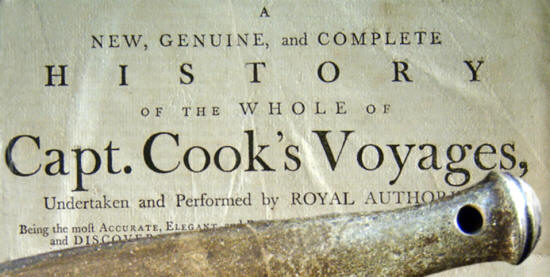
DISCOVERY OF NEW ZEALAND IS
DOMINATED
BY BRITISH EXPLORER CAPTAIN JAMES COOK
Captain Cook is the first European
explorer to describe a Maori "short club." He was the second
explorer to arrive in New Zealand in 1769, 127 years after the
original Dutch discoverer, Abel Janszoon Tasman. He made two more
stops in later voyages in New Zealand in 1773 and 1777. A fight
broke out during his first contact and several Maori were killed but
other contacts are reported to have been friendly. Captain Cook was
the first explorer to observe and describe the use of a patu (short
hand club) by a Maori warrior in
a fighting demonstration. "The old (Maori)
warrior first attacked him (a
demonstration target, not real person)
with his lance, advancing with a most furious aspect. Having pierced
him, the patoo-patoo (short hand club)
was used to demolish his head, at which he struck with a force which
would at one blow have split any man's skull: from whence we
concluded no quarter was given by these people to their foes in time
of action." |
|
|
New Zealand's first people were Polynesians.
Recent estimates of their arrival begins about AD 800 to AD 1200
during an Archaic period called Nga Kakano or "the seeds." Maori is the
word that has been used to describe these people since the
arrival of the Europeans. Abel Janszoon Tasman was the first European
explorer to discover New Zealand in 1642. When he stopped to gather
water, one of his boats was attacked and he reports that four of his men
and several Maori were killed. The second explorer to arrive, 127 years
later, was Captain Cook in 1769. On this occasion a fight broke out
during his first contact and several Maori were killed but other
contacts were reported to be friendly. Captain Cook was the first explorer
to observe and describe the use of a patu "short club" by a Mori warrior
in a fighting demonstration which he commented, "from whence we
concluded no quarter was given by these people to their foes in time of
action." The heads of fallen enemies were taken in battle, others were
kept as slaves and some were eaten. Captain Cook referred to the
close-quarter fighting and thrusting weapon as a patoo patoo. |
|
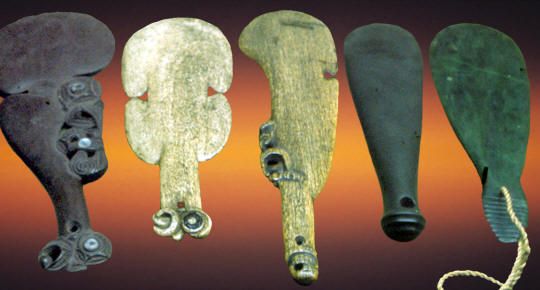
FROM LITHIC CASTING LAB'S COLLECTION OF
ORIGINAL IMAGES, DENVER ART MUSEUM, COMPUTER ALTERED
MAORI PATU SHORT "CLUBS"
WOOD, WHALEBONE AND STONE
MAORI CULTURE, NEW ZEALAND
This picture illustrates fives examples of Maori close combat
fighting weapons called patu "short hand clubs." They were made from
wood, whale bone and stone. They are all called patu, which is a
descriptive word that means club or pounder used for striking,
hitting, beating or to subdue. But more specifically, the word patu
is used along with the material. The example on the left is made of
wood and two types of patu wood "clubs" are called patu tawaka and
patu patuki. The second and third examples are made of whale bone
and they are called patu paraoa. The fourth example is made of what
is often referred to as dark-stone, greywacke, and even basalt.
These types are called patu onewa. The example on the far right is
made of New Zealand greenstone from the south island but might be
more accurately called nephrite. The stone was and still is highly
prized. So-much-so, that these types of short "clubs" were sometimes
given individual names. They are called either mere or patu pounamu.
Pounamu is the word used for greenstone and mere refers to a short
broad-bladed weapon in the shape of a tear drop, but more
specifically, one made of greenstone. |
|
|
The stone patu is often referred to as a short hand
club, even though it was used as a thrusting weapon. They began to be
used during the 17th and 18th centuries. The stone patu lost its place
as a significant fighting weapon in the 19th century with the arrival of
metal weapons. Europeans began trading daggers, swords, tomahawks, and
muskets for land and other commodities. This period marks the outbreak
of devastating wars between the Maori tribes known as the musket wars.
Between 1807 and 1842 an estimated 500 or more battles were fought.
Approximately 20% of the people in the region were killed and another
30% were enslaved or forced to migrate. Many of the slaves were made to
grow food to buy more guns. The traditional Maori close-fighting
technique with patu "clubs" and short spears ended with the arrival of
the new and advanced European weaponry. |
|
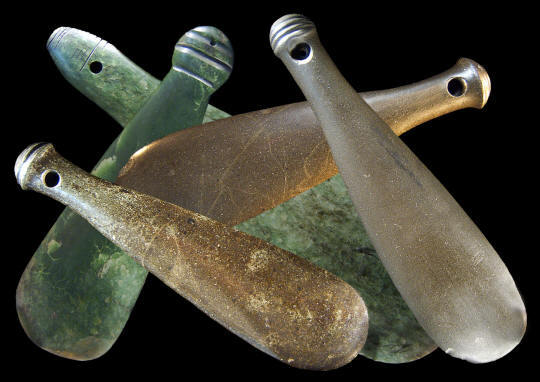
PRIVATE COLLECTION
CLICK ON PICTURE FOR LARGER IMAGE
GREENSTONE AND DARK-STONE "CLUBS"
(PATU POUNAMU & PATU ONEWA)
MAORI CULTURE, NEW ZEALAND
This group of Maori stone
patu "clubs" were made from two types of New Zealand stone that was
commonly used to make these types of fighting weapons. The green "clubs"
are called patu pounamu for greenstone and patu onewa for dark stone.
They all have a basic tear-drop shape in outline, a hole at the base of
the handle and decoration on the end of the handles in the form of
raised concentric ridges or grooves. The largest greenstone "club" in
this group measures 16 7/16 inches (41.8 cm) long, 4 5/8 inches (11.8
cm) wide and 1/2 inch (1.2 cm) thick at the center of the blade. The
longest dark stone "club" measures 13 1/2 inches (34.3 cm) long, 3 1/2
inches (8.9 cm) wide and 13/16 inch (2.1 cm) thick at the center of the
blade. |
|
|
Maori warriors are famous for their close-quarter
hand-to-hand fighting. The main weapons used, prior to European contact, were staffs, spears and
clubs. Projectile weapons were very limited. The bow and arrow and
shield were unknown and sling stones were apparently little used. They
did develop a spear-thrower called a whipsling or kataha that was used
to propel a spear or dart. Most spears were used as thrusting weapons
and not thrown. The most famous close-fighting weapons were the "short
clubs" known as mere or patu. Mere usually refers specifically to a
greenstone type and patu refers to several different types made from
whalebone, stone and wood. |
|
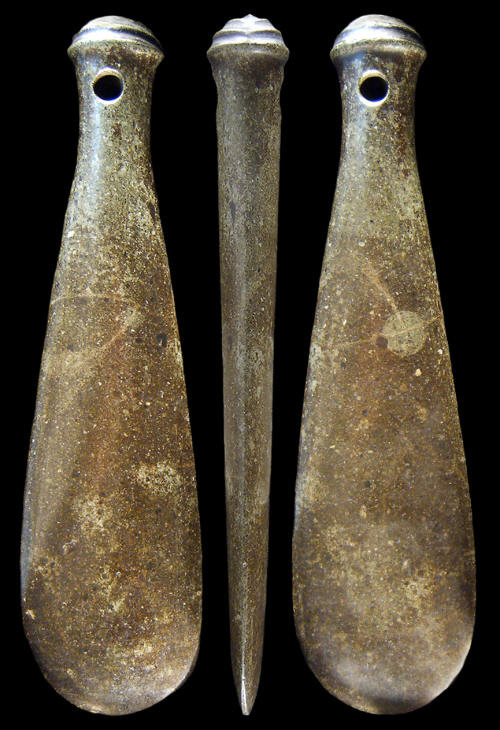
PRIVATE COLLECTION
CLICK ON PICTURE FOR LARGER IMAGE
DARK-STONE "CLUB"
(PATU ONEWA)
MAORI CULTURE, NEW ZEALAND
This patu onewa, dark stone
"club," is a "classic" example. It has a tear-drop shape, the
end of the handle has a large bi-conically drilled hole and the handle
decoration on the flared end is in the form of three concentric raised ridges and one
center ridge on the end. It appears to have been made
traditionally with primitive tools. The surface has a good polish and a
heavy patina. An old tag that was attached to it reads, "NEW ZEALAND,
Found in a London shop W. L. Waters." This patu onewa is made of a
slightly greenish colored dark-stone, known as greywacke. It measures 12
7/8 inches (32.7 cm) long, 3 5/8 inches (9.2 cm) wide and 11/16 inch
(1.7 cm) thick at the center of the blade. |
|
|
Writers have referred to the Maori weapons
illustrated in this report, in general terms, as clubs, short clubs,
short sword-clubs, hand clubs, patoo patoo, mere, patu and even battle
axes. But each type does have a more specific name. The beautiful green
"jade-like" examples are more correctly called either mere or patu
pounamu. Mere is the word used for a short broad-bladed weapon in the
shape of a tear drop and refers to the greenstone type.
Pounamu is the word for greenstone and Patu is a descriptive word that
means club or pounder used for striking, hitting, beating or to subdue.
The word patu is used along with the material, such as Patu paraoa for
whalebone. The darker more gray examples, in this report, are called
patu onewa. Onewa refers to the more common dark stone called greywacke. |
|
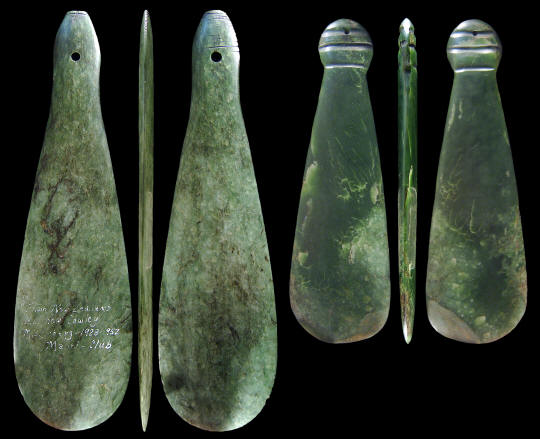
PRIVATE COLLECTION
CLICK ON PICTURE FOR LARGER IMAGE
GREENSTONE "HAND CLUBS"
(PATU POUNAMU)
MAORI CULTURE,
NEW ZEALAND
Both of these patu
pounamu were probably made sometime in the 1900's. The larger mere on
the left is inscribed on one side in white ink with, "From New Zealand,
Matthew Cowley Missionary----1928-1952, Maori-Club." Mr. Cowley was a
Mormon missionary who was born in Idaho. He learned the Maori language
and wrote his diaries in Maori. His most remarkable achievement was a
revision of the Maori text of "The Book Of Mormon." He first arrived in
Auckland in 1914 and preached in a Mormon mission until 1919 when he
left to attend the George Washington law school. He later returned to
New Zealand in 1938 until 1945. He died in 1953. This patu pounamu
"club" may have been a gift for his time spent in New Zealand. This
"club" is made of a lighter color greenstone and it measures 16 7/16
inches (41.8 cm) long, 4 5/8 inches (11.8 cm) wide and 1/2 inch (1.2 cm)
thick at the center of the blade. The hole was drilled through from one
side in a non-traditional way. But it appears to have been done in a
primitive way that left ridges of rings on the surface of the interior wall.
The patu pounamu "club" on the right was made from a beautiful dark
green and semi-translucent colored greenstone. Although small, the hole
seems to have been drilled traditionally from both sides in an hourglass
shape. There is considerable damage on a large area of the end of the
blade that was restored. This "club" measures 11 11/16 inches (29.7 cm)
long, 3 5/8 inches (9.2 cm) wide, and 5/8 inch (1/6 cm) thick at the
center of the blade.
The Maori considered
greenstone the most highly prized of all stones. Their
most valued personal wealth was considered to be their worked and
unworked greenstone made into adzes, clubs and ornaments, plus finely
woven flax garments and canoes. Maori tradition developed a mythical origin
for greenstone and
a certain quality of life. A Maori named Te Otatu once remarked, "let
the gold be worked by the white man. It was not a thing known by our
ancestors. My only treasure is the pounamu (greenstone)." The stone has
been referred to as greenstone, nephrite, jade, jadeite, green talc, and bowenite, plus several native names. There are different types of New
Zealand greenstone. The hardest variety of nephrite was the most desired
for tools. |
|
|
Patu onewa "dark stone clubs" were made from the more common
and softer stone called greywacke. Greywacke is a type of sedimentary
rock that is found in many areas of New Zealand. More "stone clubs" were
made from greywacke, prior to European contact, than greenstone because
it was readily available and easier to work. In outline, the two
different types of stone clubs are basically the same. The difference is
in their thickness. The greywacke "clubs" were made slightly thicker so
they could withstand rough treatment. The material density of the
greenstone "clubs" allowed them to be much thinner. |
|
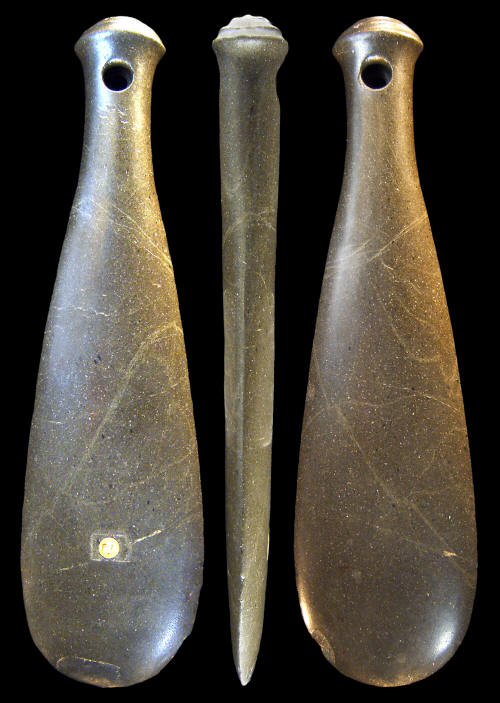
PRIVATE COLLECTION
CLICK ON PICTURE FOR LARGER IMAGE
DARK-STONE "CLUB"
(PATU ONEWA)
MAORI CULTURE, NEW ZEALAND
This patu onewa, dark stone
"club," appears to be fairly old. It does have a good original patina
and there is a couple of large flakes missing from the end of the blade.
It has a large biconically drilled hole and a typical raised ridge
design on the end of the handle. It measures 13 3/16 inches (33.5 cm)
long, 3 11/16 inches (9.3 cm) wide and 13/16 inch (2.1 cm) thick. |
|
|
Patu pounamu (greenstone clubs)
were considered special objects. Maori tradition developed a mythical origin
for greenstone and a certain quality of life. The extreme hardness of
the best quality greenstone also required a
craftsman to invest many years of labor to complete a single mere or
patu pounamu. Some "greenstone clubs" are reported to have taken several
years or even a generation to produce. They were made in the same way
other ground and polished stone tools were made. The difference is that
each manufacturing step took such an extraordinary amount of time to
complete
compared to other much less harder stones. |
|

PRIVATE COLLECTION
"RECENT" GREENSTONE "CLUBS"
(PATU POUNAMU)
MAORI CULTURE, NEW ZEALAND
Both of these greenstone
"club" appear to be of recent manufacture. The example on the left has a
peculiar matt finish and the example on the right is very small. Maori
style stone "clubs" are still being made in all sizes with modern tools. |
|
|
All mere and stone patu "clubs" have one hole drilled
through the end of the handle. A thong of dog hide was looped through
the hole and attached securely to the hand, thumb, and wrist. Early accounts describe a
type of cord drill that was used to drill the holes, later accounts, after
European contact, report that the pump drill was introduced. The cord
drill assembly includes a shaft, two rocks of equal weight, a stone bit,
and a cord. The rocks acted as a flywheel. It would seem that the cords
would have needed two people to operate, pulling from each side, but
some accounts claim it was used by a single person. Some of the early
reports claim a wooden bit was used to drill the holes, but several
tribes are recorded to have described only stone bits were used. A short
"spike" of quartz is described in one account. As the shaft was turned,
water and quartz sand was added to the drilling process. The hole was
drilled to the center of the handle then turned and drilled from the
opposite side. The holes have wide diameters on the surface but narrow
to an hourglass shape towards the center. |
|
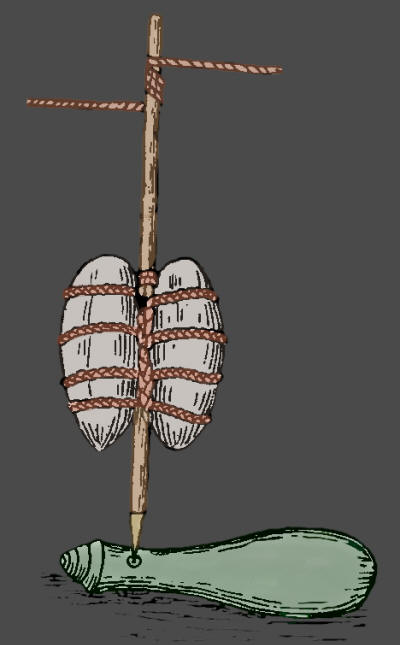
ILLUSTRATION FROM 1894 SMITHSONIAN ANNUAL REPORT, COMPUTER ALTERED
BY PETE BOSTROM
CORD DRILL
MAORI CULTURE
NEW ZEALAND
This picture
shows a drawing of an example of the type of drill that was used by the
Maori to drill the holes in their "stone clubs." All mere and stone patu
"clubs" have one hole drilled through the end of the handle. A thong of
dog hide was looped through the hole and attached securely to the hand
and wrist. Early accounts describe a type of cord drill was used to
drill the holes, later accounts, after European contact, report that the
pump drill was introduced. The cord drill assembly includes a shaft, two
rocks of equal weight, a stone bit, and a cord. The rocks acted as a
flywheel. It would seem that the cords would have needed two people to
operate, pulling from each side, but some accounts claim it was used by
a single person. Some of the early reports claim that a wooden bit was
used to drill the holes, but several tribes are recorded to have
described only stone bits were used. A short "spike" of quartz is
described in one account. As the shaft was turned, water and quartz sand
was added to the drilling process. The hole was drilled to the center of
the handle then turned and drilled from the opposite side. The holes
have wide diameters on the surface but narrow to an hourglass shape
towards the center. |
|
|
The Maori of New Zealand developed an extraordinary
society
from a simple beginning to a highly developed culture by the time of
Captain Cook's arrival. The people originally lived on moa birds, sweet
potatoes and taro. Their most notable loss of a natural resource was the
moa, after 400 years of hunting. It's an old trend-line, as natural
resources disappear and populations increase, the people become more
war-like. Sometimes unique weapons begin to appear, like the Mataa
spears on Easter Island and of course, in this case, we have the
wonderful examples of patu pounamu and patu onewa. They are brave men's
weapons from a time long ago. |
|
"REFERENCES"
1784-1886, from account of Captain
Cook's first voyage within bound text published in 80 parts, George
William Anderson, "---Complete Collection Of Voyages Round The
World---Captain Cook's First, Second, Third And Last Voyages,---" p.
45-46.
1870, Huxley, Professor & Busk, George, "The Journal Of The
Ethnological Society Of London V2: Session 1869-70, p. 106-109
1894, McGuire, J. D., "A study Of The Primitive Methods Of
Drilling," Annual Report Of The Board Of Regents Of The Smithsonian
Institution, pp. 714-715.
1912, Best, Elsdon, "The Stone Implements Of The Maori," p. 68.
1945, Mead, Margaret, "The Maoris And Their Arts", p. 21.
1952, Hiroa, Te Rangi, "The Coming Of The Maori," pp. 271-281.
1964, T. Barrow, "The Decorative Arts Of The New Zealand Maori, p.
38.
1967, Archey, Gilbert, "South Sea Folk, Handbook Of Maori And
Oceanic Ethnology," pp. 35-39.
1971, Pearce, G. L., "Greenstone, The Story Of New Zealand Jade," p.
49.
1995, Meyer, Anthony JP, "Oceanic Art, Vol. II, p. 546.
2000, Lal, Brij V., & Fortune, Kate, "The Pacific Islands, An
Encyclopedia," pp. 114 & 149.
2010, Starzecka, Dorota C., Neich, Roger & Pendergrast, Mick, "The
Maori Collections Of The British Mueum, pp. 74-89.
Personal Communication, Dennis Vesper.
|
|
RECENT
LISTINGS HOME
ORDERING |